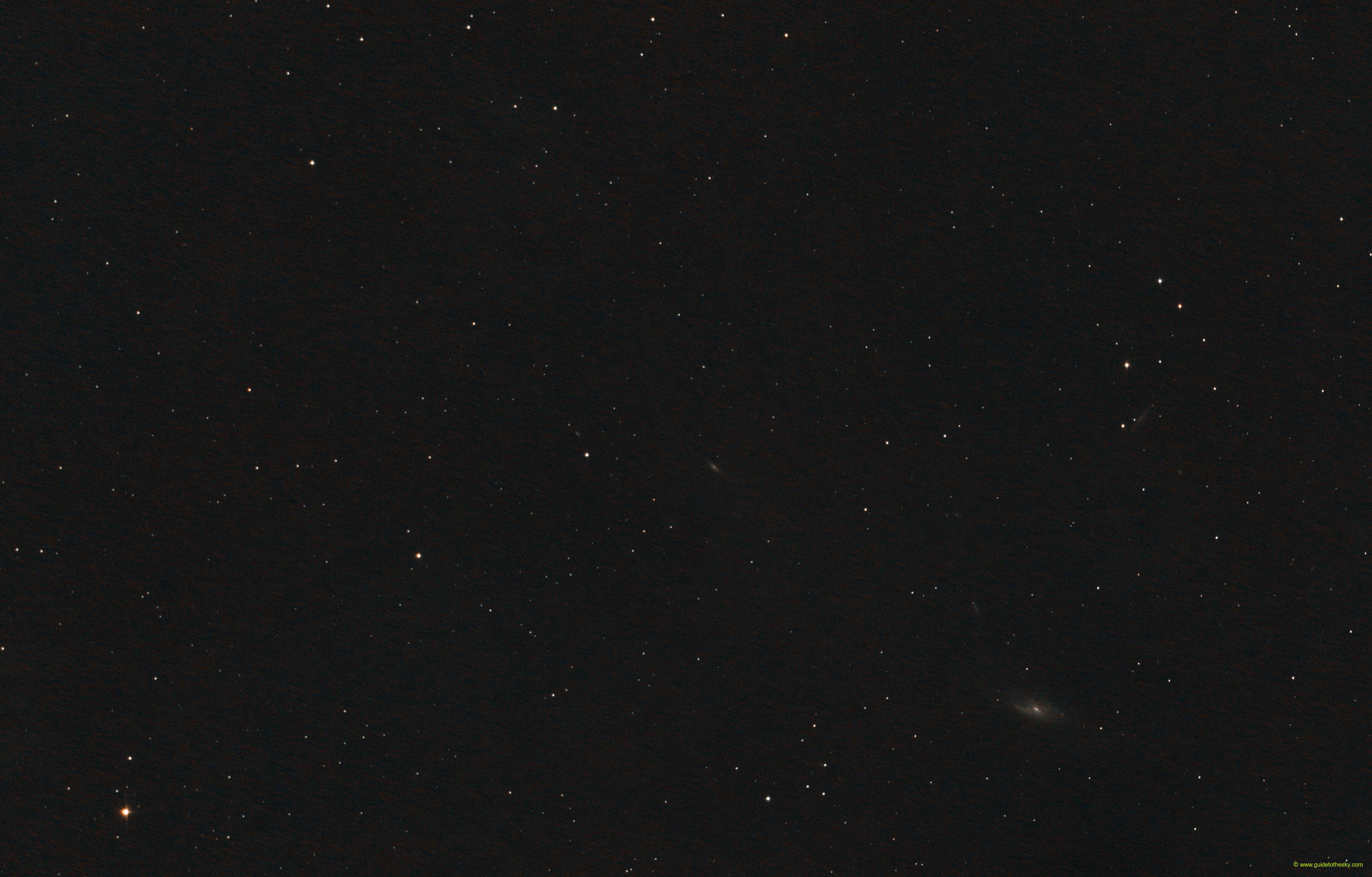Messier 106 - Canes Venatici

M 106 es una galaxia relativamente cercana situada a {{ object[0].M106.mesDistances[0].dist }} {{ object[0].M106.mesDistances[0].unit }} de distancia, pertenece a un grupo cercano de galaxias llamado el grupo de Canes II.
Otras galaxias podemos ver en el mismo campo, como NGC 4220 mucho más débil y no perteneciente al mismo grupo que M106 pues también es mucho más lejana. Incluso la pequeña NHC 4232 que brilla desde más de 100Mpc de distancia.
Curiosamente, M106 no tiene un nombre propio, todavía.
M106 - - en la IA
Messier 106 (M106), also known as NGC 4258, is a fascinating intermediate spiral galaxy located in the constellation Canes Venatici, approximately 22 to 25 million light-years away from Earth. Here's a breakdown of its key features and why it's scientifically significant:
Key Characteristics:
- Spiral Galaxy: M106 is classified as an intermediate spiral galaxy. This means it falls between a barred spiral (like our Milky Way) and a "normal" spiral. It has a faint bar-like structure at its center.
- Size and Brightness: It's a relatively large and bright galaxy, with a diameter of about 135,000 light-years, making it slightly larger than the Milky Way. It has a visual magnitude of around 8.4, making it visible through binoculars under dark skies.
- Active Galactic Nucleus (AGN): This is one of the most important aspects of M106. It houses a supermassive black hole at its center, which is actively accreting matter and emitting large amounts of energy across the electromagnetic spectrum, including radio waves, X-rays, and visible light. The AGN is classified as a Seyfert II galaxy.
- Anomalous Spiral Arms (Water Masers): M106 exhibits unusual spiral arms made of hot gas. These "anomalous arms" are not composed of stars and dust like typical spiral arms. Instead, they consist of gas heated by shock waves generated by jets of particles emanating from the supermassive black hole. These jets collide with the galaxy's disk, creating the observed structure. Importantly, these arms are detected through radio emissions of water masers (masers are microwave lasers). The water masers provide precise measurements of the galaxy's distance and the mass of the central black hole.
- Distance and Mass Measurements: The water masers in M106 have been crucial for establishing an accurate distance to the galaxy, independently of the standard "cosmic distance ladder" techniques. They also allow for a very precise determination of the mass of the central supermassive black hole, estimated to be around 40 million times the mass of the Sun.
- Star Formation: M106 has regions of intense star formation, particularly in its spiral arms.
Scientific Significance:
- AGN Research: M106 serves as an important laboratory for studying active galactic nuclei and the processes occurring in the vicinity of supermassive black holes. Its relatively close proximity and the presence of water masers make it an ideal target for detailed observations.
- Distance Determination: The precise distance measurement obtained using the water masers has helped to refine our understanding of the expansion rate of the universe (the Hubble constant) and potentially resolve discrepancies between different measurement methods.
- Galaxy Dynamics: The interaction between the AGN jets and the galaxy's disk provides insights into how supermassive black holes can influence the evolution and structure of their host galaxies. The study of the anomalous arms contributes to our understanding of galactic dynamics.
- Testing Cosmological Models: By providing accurate distance measurements to galaxies like M106, astronomers can test and refine cosmological models of the universe.
Observing M106:
- Location: It's located in the constellation Canes Venatici, near the Big Dipper (Ursa Major).
- Equipment: A telescope is required to observe M106 in detail. Binoculars can reveal it as a faint, fuzzy patch under dark skies.
- Appearance: Through a telescope, you can see the galaxy's bright central region and the faint, diffuse spiral arms. The anomalous arms are not visible in optical light and require radio telescopes to be detected.
In Summary:
Messier 106 is a fascinating spiral galaxy with an active galactic nucleus and unusual spiral arms. Its importance stems from its role in understanding AGN physics, precisely measuring distances, and probing the dynamics of galaxies. It's a valuable object for both amateur astronomers with telescopes and professional researchers alike.
Más información sobre Messier 106 en NASA/IPAC.
Mapa alrededor de Messier 106
Otros identificadores de M106:
"WN B1216.4+4735" ,"WN B1216.4+4735B" ,"NVSS J121855+471847" ,"VLSSr J121855.7+471836" ,"[ZEH2003] RX J1219.0+4717 1" ,"[KRL2007b] 111" ,"B3 1216+475" ,"GB1 1216+476" ,"LEDA 39600" ,"M 106" ,"MCG+08-22-104" ,"NGC 4258" ,"OHIO N 427" ,"RX J1219.0+4717" ,"UGC 7353" ,"VV 448" ,"XSS J12190+4715" ,"Z 243-67" ,"Z 244-3" ,"[CPF88] 121629.0+473500.0" ,"[VDD93] 154" ,"2MASX J12185761+4718133" ,"1RXP J121856.4+471755" ,"1RXS J121900.4+471747" ,"RX J1218.9+4718" ,"SAX J1219.7+4721" ,"UZC J121857.7+471820" ,"Z 1216.5+4735" ,"[CHM2007] HDC 706 J121857.61+4718133","[CHM2007] LDC 867 J121857.61+4718133","[M98c] 121629.7+473455" ,"[VV2000c] J121857.5+471814" ,"[VV2003c] J121857.5+471814" ,"[VV2006c] J121857.5+471814" ,"[VV98c] J121857.5+471814" ,"PBC J1218.9+4718" ,"SWIFT J1219.4+4720" ,"SWIFT J1219.0+4715" ,"[VV2010c] J121857.5+471814" ,"[BAG2012] 184.7378+47.2874" ,"SDSS J121857.50+471814.3" ,"2XMM J121857.5+471814" ,"87GB 121625.0+473537" ,"GB6 B1216+4735" ,"MY 121625.0+471813.7" ,"WB 1216+4735" ,"7C 121620.39+473545.00" ,"7C 121626.19+473526.00" ,"7C 121635.39+473404.00" ,"VLSS J1218.9+4718" ,"[NKB95] N4258" ,"SWIFT J1218.9+4717" ,

